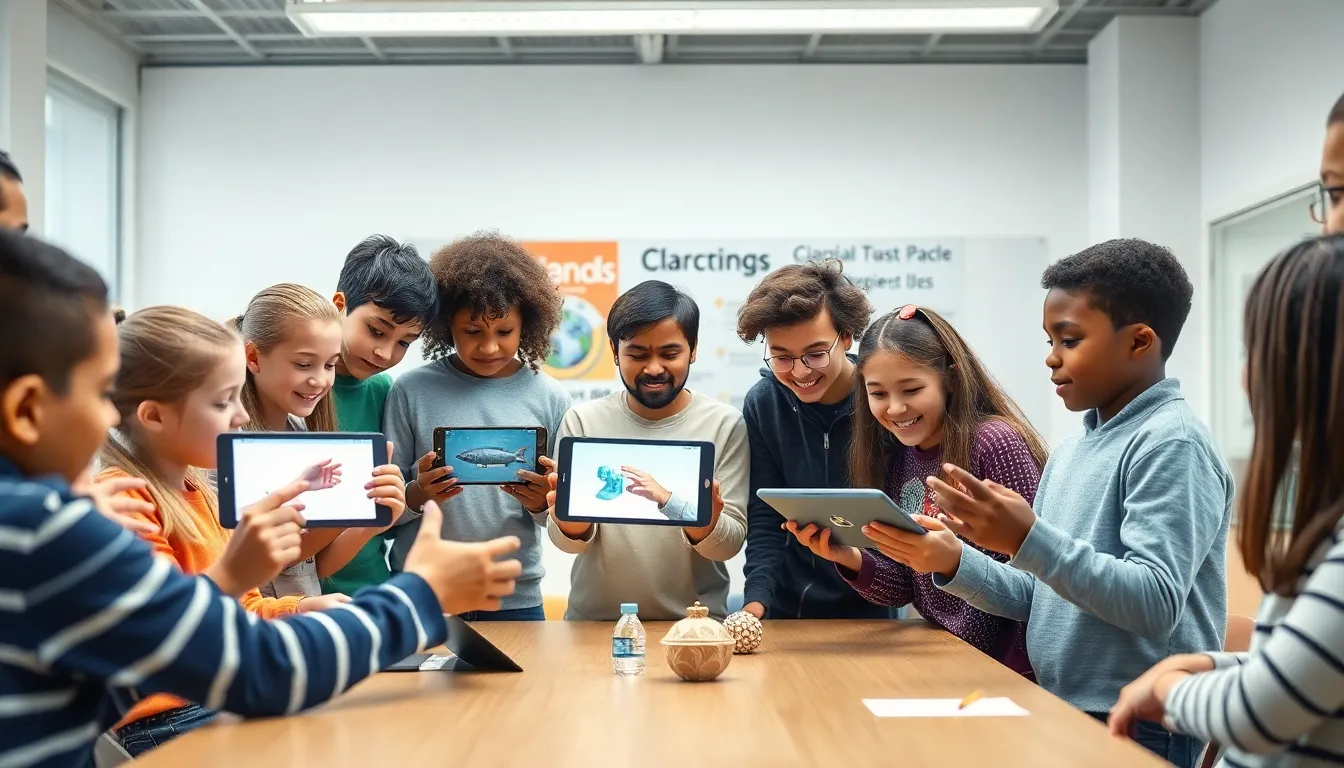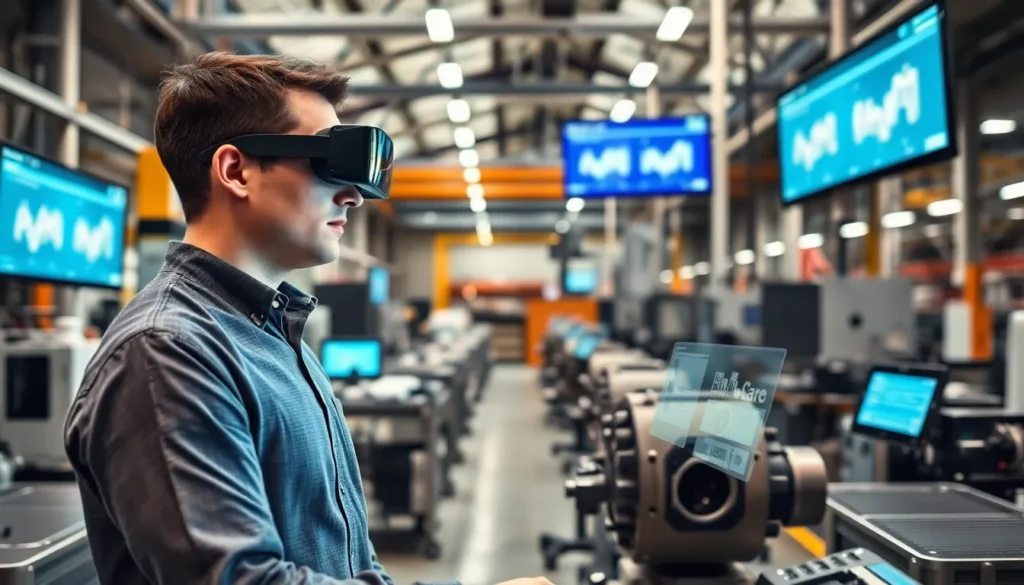Imagine a world where learning feels like a game and knowledge leaps off the page—literally! Enter AR flashcards, the futuristic twist on traditional study tools that’s turning the educational landscape upside down. These aren’t your grandma’s flashcards; they’re packed with augmented reality magic that brings subjects to life, making memorization as fun as a cat video binge.
Table of Contents
ToggleOverview of AR Flashcards
AR flashcards offer a dynamic approach to learning. By integrating augmented reality, these educational tools provide an interactive experience, enhancing traditional memorization techniques. Users can simply scan the cards with a smartphone or tablet, bringing illustrations and animations to life.
Engagement levels increase significantly with AR flashcards. Students experience visuals that reinforce content, making material more memorable. They also foster active learning, focusing on participation instead of passive review.
The technology behind AR flashcards utilizes smartphone applications that recognize specific images. Once identified, the application overlays digital information on the real-world view, offering an immersive learning experience. Various subjects, from vocabulary to science concepts, benefit from this interactive format.
Some AR flashcard platforms include features like quizzes and games. Incorporating these elements allows for immediate feedback, enhancing the learning process. Collaborative tools also encourage group study sessions, making it a versatile option for different learning environments.
Teachers report positive outcomes using AR flashcards in classrooms. Increased student motivation and improved retention rates contribute to their growing popularity. Many educators integrate AR flashcards into lesson plans, maximizing their effectiveness across various age groups.
Overall, AR flashcards represent a significant advancement in educational technology. They bridge the gap between the digital and physical worlds, setting a new standard for how students engage with their studies.
Benefits of Using AR Flashcards

AR flashcards provide several advantages that enhance the learning experience for users. By integrating technology with study methods, they transform how students engage with educational material.
Enhanced Learning Experience
Engaging visuals significantly aid comprehension, making complex ideas easier to understand. AR flashcards illustrate concepts through animations and 3D models, providing clarity that static images cannot. Students who interact with this content demonstrate improved information retention, as the immersive experience aids memory. Evidence supports that multi-sensory learning increases effectiveness, giving learners tools to grasp intricate subjects. Many platforms allow personalized learning paths, catering to individual preferences and pacing.
Engagement and Interactivity
High levels of interactivity keep students actively involved in their learning journey. Traditional flashcards often result in passive review, but AR flashcards change that dynamic. Users scan cards to unlock quizzes, games, and interactive content, turning study sessions into engaging experiences. Immediate feedback during activities reinforces learning, enabling quicker adjustments to strategies. Active participation leads to deeper understanding, encouraging collaborative study formats. Teachers notice that increased engagement correlates with higher motivation and better academic performance, showcasing the impact of this innovative approach.
How AR Flashcards Work
AR flashcards utilize augmented reality to create an interactive learning environment. Through smartphones or tablets, users can scan these cards, unveiling animations and graphics that enhance comprehension.
Technology Behind AR Flashcards
The technology relies on image recognition in dedicated applications. These apps identify specific visuals on the cards and overlay digital content onto them. This system merges physical and digital learning experiences, allowing students to engage actively with the subject matter. Various subjects such as languages and science can utilize this format effectively. Additionally, some platforms incorporate gamification elements, further increasing student interaction.
Creating AR Flashcards
Designing AR flashcards involves several key steps. First, educators choose relevant content to present, ensuring it fits educational objectives. Next, images or illustrations are selected that effectively represent each concept. Software tools or apps are used to link digital animations or information to the visuals on the cards. Finally, testing ensures the cards work seamlessly with users’ devices. This structured approach leads to the development of effective learning tools that captivate students’ attention.
Popular AR Flashcard Apps
Numerous AR flashcard apps enhance the learning experience for students of all ages. Some of the leading platforms include:
- Quivr: This app lets users capture their own flashcards and combine them with AR content. The interactive features allow students to link digital resources, making it versatile for various subjects.
- AR Flashcards: Targeting younger learners, this tool combines simple animal images with engaging AR visuals. Kids enjoy interacting with animated creatures while learning essential vocabulary.
- Zappar: Focused on gamification, Zappar incorporates games and quizzes into the flashcard experience. Learners can earn rewards, making the educational process enjoyable and competitive.
- Merge Cube: This app integrates physical and digital learning using a tangible cube. Users explore 3D models, turning abstract concepts into concrete learning experiences.
- Aurasma (now HP Reveal): Aurasma allows educators to create interactive flashcards linked to digital content. The platform supports customizable enhancements, making lessons unique and personalized.
- Flashcard Machine: While primarily a traditional flashcard app, it provides an AR feature that enriches study sessions. Students can connect their flashcards to AR animations, establishing a modern twist on classic studying methods.
Various classrooms utilize these apps to motivate students more effectively. Teachers appreciate the immediate feedback and engaging lessons that promote retention. Research indicates higher engagement rates translate to improved comprehension across subjects.
Also, these apps cater to diverse learning styles, accommodating visual and auditory learners alike. With such a range of options, AR flashcards continue to gain traction, transforming the future of educational technology.
AR flashcards represent a significant leap in educational tools that blend the physical and digital worlds. By transforming traditional study methods into interactive experiences, they captivate students’ attention and enhance retention. The ability to visualize and engage with content through animations and quizzes fosters a deeper understanding of complex ideas.
As educators increasingly adopt this technology, the positive feedback highlights its effectiveness in boosting motivation and participation. With various apps available to support diverse learning styles, AR flashcards are not just a trend but a valuable resource that enriches the learning journey. Embracing this innovative approach can lead to improved academic performance and a more engaging classroom environment.





